headlamp BUICK REGAL 2004 User Guide
[x] Cancel search | Manufacturer: BUICK, Model Year: 2004, Model line: REGAL, Model: BUICK REGAL 2004Pages: 354, PDF Size: 4.16 MB
Page 111 of 354
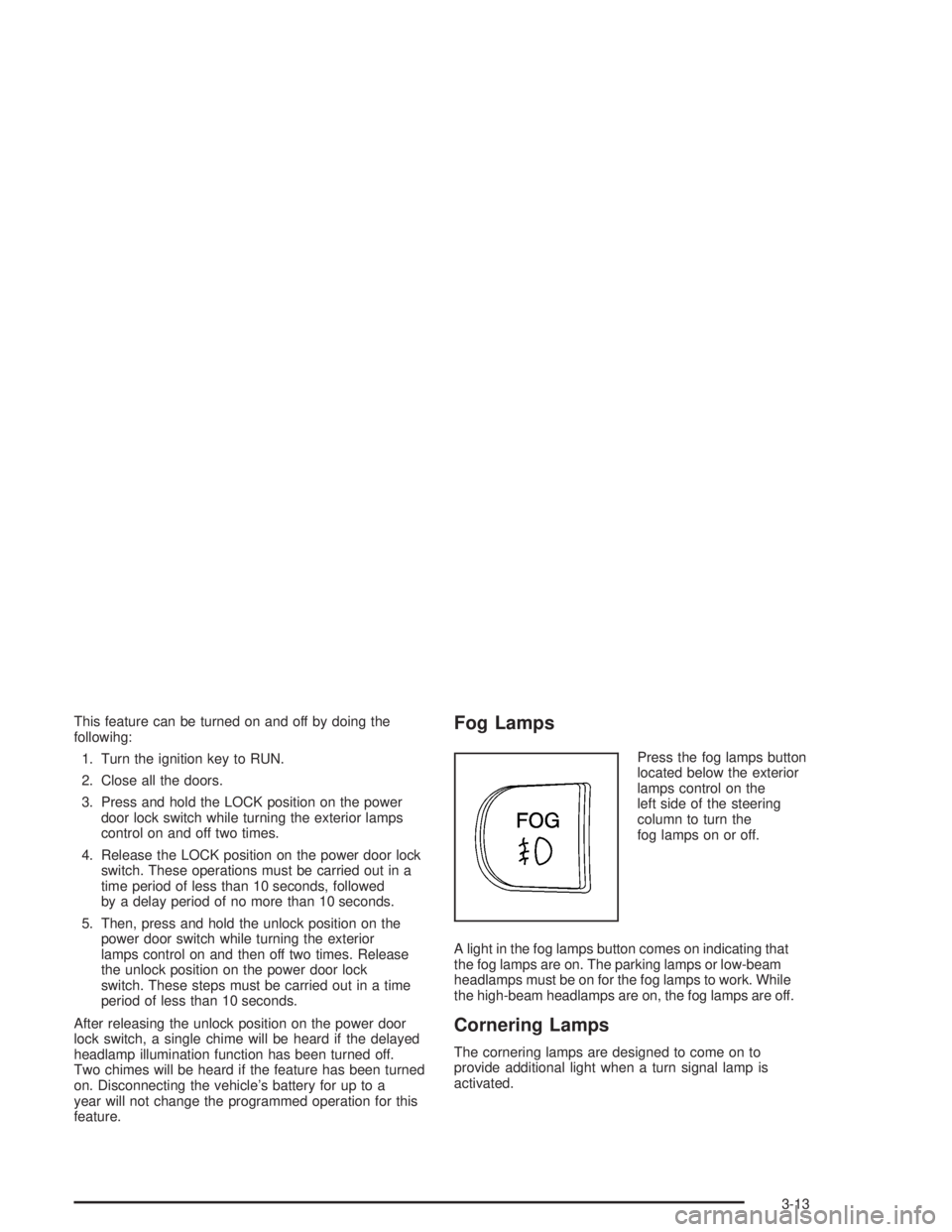
This feature can be turned on and off by doing the
followihg:
1. Turn the ignition key to RUN.
2. Close all the doors.
3. Press and hold the LOCK position on the power
door lock switch while turning the exterior lamps
control on and off two times.
4. Release the LOCK position on the power door lock
switch. These operations must be carried out in a
time period of less than 10 seconds, followed
by a delay period of no more than 10 seconds.
5. Then, press and hold the unlock position on the
power door switch while turning the exterior
lamps control on and then off two times. Release
the unlock position on the power door lock
switch. These steps must be carried out in a time
period of less than 10 seconds.
After releasing the unlock position on the power door
lock switch, a single chime will be heard if the delayed
headlamp illumination function has been turned off.
Two chimes will be heard if the feature has been turned
on. Disconnecting the vehicle’s battery for up to a
year will not change the programmed operation for this
feature.Fog Lamps
Press the fog lamps button
located below the exterior
lamps control on the
left side of the steering
column to turn the
fog lamps on or off.
A light in the fog lamps button comes on indicating that
the fog lamps are on. The parking lamps or low-beam
headlamps must be on for the fog lamps to work. While
the high-beam headlamps are on, the fog lamps are off.
Cornering Lamps
The cornering lamps are designed to come on to
provide additional light when a turn signal lamp is
activated.
3-13
Page 113 of 354

Delayed Exit Lighting
This feature illuminates the interior for a period of time
after the ignition key is removed from the ignition.
When the ignition key is removed, interior illumination
will activate and remain on until one of the following
occurs:
The ignition is in RUN.
The power door locks are activated.
Twenty �ve seconds has elapsed.
If during the illumination period a door is opened, the
timed illumination period will be canceled and the interior
lamps will remain on.
Perimeter Lighting
Perimeter lighting provides a period of exterior vehicle
lighting. Perimeter lighting activates when the doors
are closed, the ignition is in OFF and the security
feedback feature is activated in Mode 3 or 4. See
“Security Feedback” underRemote Keyless Entry
System Operation on page 2-4for more information.
The vehicle headlamps and back-up lamps are
then activated for a period of 25 seconds or until the
ignition switch is turned to RUN.Perimeter lighting can be turned on or off when the
driver performs the following sequence with the engine
off and the doors closed:
1. Turn the ignition to RUN.
2. Close all the doors.
3. Apply the brake.
4. Press and hold the LOCK position on the power
door lock switch while pressing and releasing the
remote alarm button on the remote keyless
entry transmitter.
This activates the customization mode. While in the
customization mode, the number of chimes
corresponding to the current mode will sound. One
chime means the feature is turned off. Two chimes
mean that the perimeter lighting feature is turned on.
Each additional press of the power door lock switch will
advance to the next mode. Release the LOCK position
on the power door lock switch to set the mode.
Disconnecting the vehicle’s battery for up to a year will
not change the programmed operation for this feature.
Reading Lamps
The reading lamps are located on the underside of the
rearview mirror. Press the button next to each lamp
to turn it on and off.
3-15
Page 179 of 354
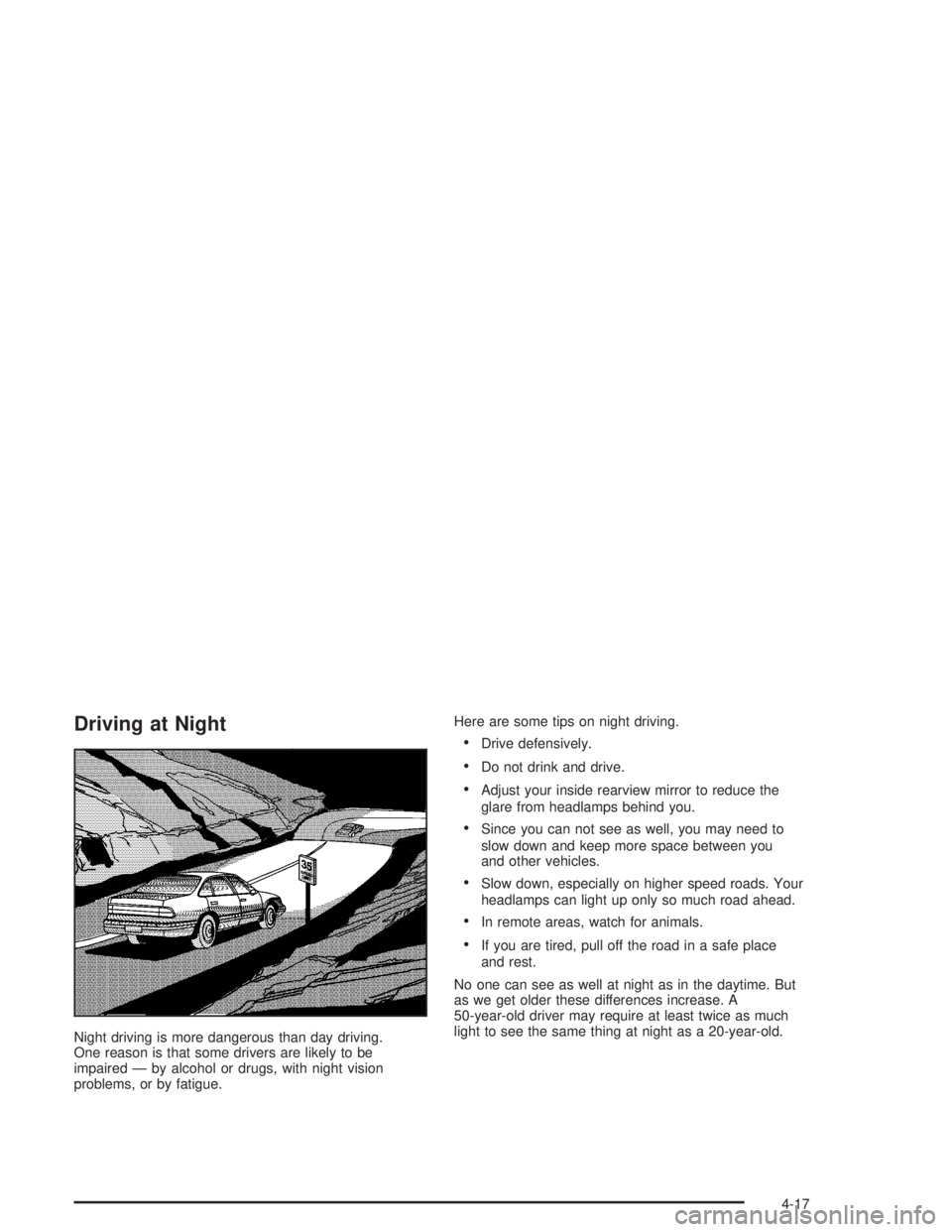
Driving at Night
Night driving is more dangerous than day driving.
One reason is that some drivers are likely to be
impaired — by alcohol or drugs, with night vision
problems, or by fatigue.Here are some tips on night driving.
Drive defensively.
Do not drink and drive.
Adjust your inside rearview mirror to reduce the
glare from headlamps behind you.
Since you can not see as well, you may need to
slow down and keep more space between you
and other vehicles.
Slow down, especially on higher speed roads. Your
headlamps can light up only so much road ahead.
In remote areas, watch for animals.
If you are tired, pull off the road in a safe place
and rest.
No one can see as well at night as in the daytime. But
as we get older these differences increase. A
50-year-old driver may require at least twice as much
light to see the same thing at night as a 20-year-old.
4-17
Page 180 of 354
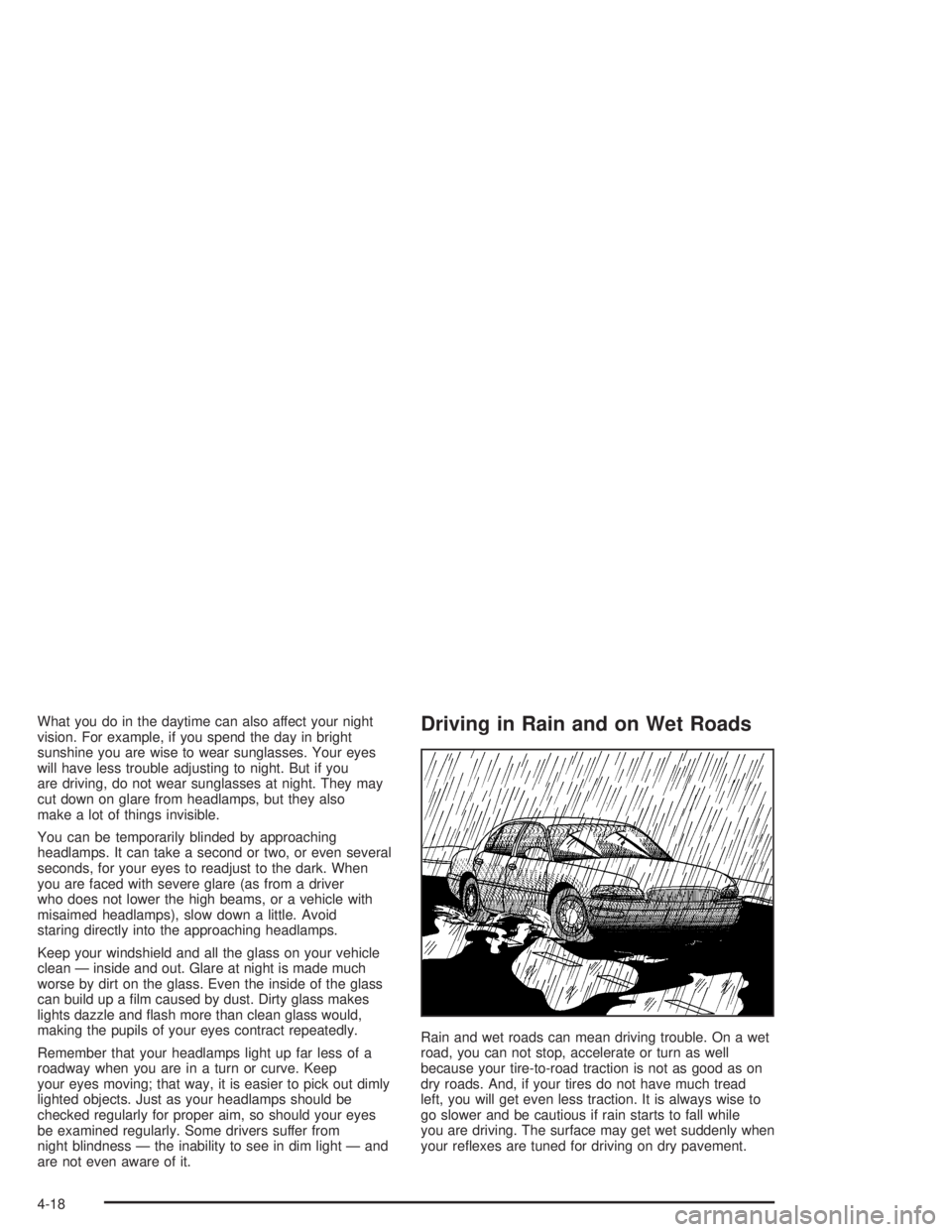
What you do in the daytime can also affect your night
vision. For example, if you spend the day in bright
sunshine you are wise to wear sunglasses. Your eyes
will have less trouble adjusting to night. But if you
are driving, do not wear sunglasses at night. They may
cut down on glare from headlamps, but they also
make a lot of things invisible.
You can be temporarily blinded by approaching
headlamps. It can take a second or two, or even several
seconds, for your eyes to readjust to the dark. When
you are faced with severe glare (as from a driver
who does not lower the high beams, or a vehicle with
misaimed headlamps), slow down a little. Avoid
staring directly into the approaching headlamps.
Keep your windshield and all the glass on your vehicle
clean — inside and out. Glare at night is made much
worse by dirt on the glass. Even the inside of the glass
can build up a �lm caused by dust. Dirty glass makes
lights dazzle and �ash more than clean glass would,
making the pupils of your eyes contract repeatedly.
Remember that your headlamps light up far less of a
roadway when you are in a turn or curve. Keep
your eyes moving; that way, it is easier to pick out dimly
lighted objects. Just as your headlamps should be
checked regularly for proper aim, so should your eyes
be examined regularly. Some drivers suffer from
night blindness — the inability to see in dim light — and
are not even aware of it.Driving in Rain and on Wet Roads
Rain and wet roads can mean driving trouble. On a wet
road, you can not stop, accelerate or turn as well
because your tire-to-road traction is not as good as on
dry roads. And, if your tires do not have much tread
left, you will get even less traction. It is always wise to
go slower and be cautious if rain starts to fall while
you are driving. The surface may get wet suddenly when
your re�exes are tuned for driving on dry pavement.
4-18
Page 191 of 354

Put on extra clothing or wrap a blanket around you.
If you have no blankets or extra clothing, make
body insulators from newspapers, burlap bags, rags,
�oor mats — anything you can wrap around
yourself or tuck under your clothing to keep warm.
You can run the engine to keep warm, but be careful.
{CAUTION:
Snow can trap exhaust gases under your
vehicle. This can cause deadly CO (carbon
monoxide) gas to get inside. CO could
overcome you and kill you. You can not see it
or smell it, so you might not know it is in your
vehicle. Clear away snow from around the
base of your vehicle, especially any that is
blocking your exhaust pipe. And check around
again from time to time to be sure snow does
not collect there.
Open a window just a little on the side of the
vehicle that is away from the wind. This will
help keep CO out.
Run your engine only as long as you must. This saves
fuel. When you run the engine, make it go a little
faster than just idle. That is, push the accelerator
slightly. This uses less fuel for the heat that you get and
it keeps the battery charged. You will need a
well-charged battery to restart the vehicle, and possibly
for signaling later on with your headlamps. Let the
heater run for a while.
4-29
Page 209 of 354

Service............................................................5-3
Doing Your Own Service Work.........................5-3
Adding Equipment to the Outside of Your
Vehicle......................................................5-4
Fuel................................................................5-4
Gasoline Octane............................................5-4
Gasoline Speci�cations....................................5-5
California Fuel...............................................5-5
Additives.......................................................5-6
Fuels in Foreign Countries...............................5-6
Filling Your Tank............................................5-7
Filling a Portable Fuel Container.......................5-9
Checking Things Under the Hood....................5-10
Hood Release..............................................5-11
Engine Compartment Overview.......................5-12
Engine Oil...................................................5-16
Supercharger Oil..........................................5-21
Engine Air Cleaner/Filter................................5-22
Automatic Transaxle Fluid..............................5-24
Engine Coolant.............................................5-26
Radiator Pressure Cap..................................5-29
Engine Overheating.......................................5-29Cooling System............................................5-32
Power Steering Fluid.....................................5-40
Windshield Washer Fluid................................5-42
Brakes........................................................5-43
Battery........................................................5-46
Jump Starting...............................................5-47
Headlamp Aiming...........................................5-53
Bulb Replacement..........................................5-55
Halogen Bulbs..............................................5-55
Headlamps..................................................5-55
Front Turn Signal and Parking Lamps..............5-56
Center High-Mounted Stoplamp (CHMSL).........5-57
Taillamps, Turn Signal, and Stoplamps............5-58
Back-Up Lamps............................................5-59
Windshield Wiper Blade Replacement..............5-60
Tires..............................................................5-61
In�ation - Tire Pressure.................................5-68
Tire Pressure Monitor System.........................5-69
Tire Inspection and Rotation...........................5-70
When It Is Time for New Tires.......................5-72
Buying New Tires.........................................5-72
Section 5 Service and Appearance Care
5-1
Page 210 of 354
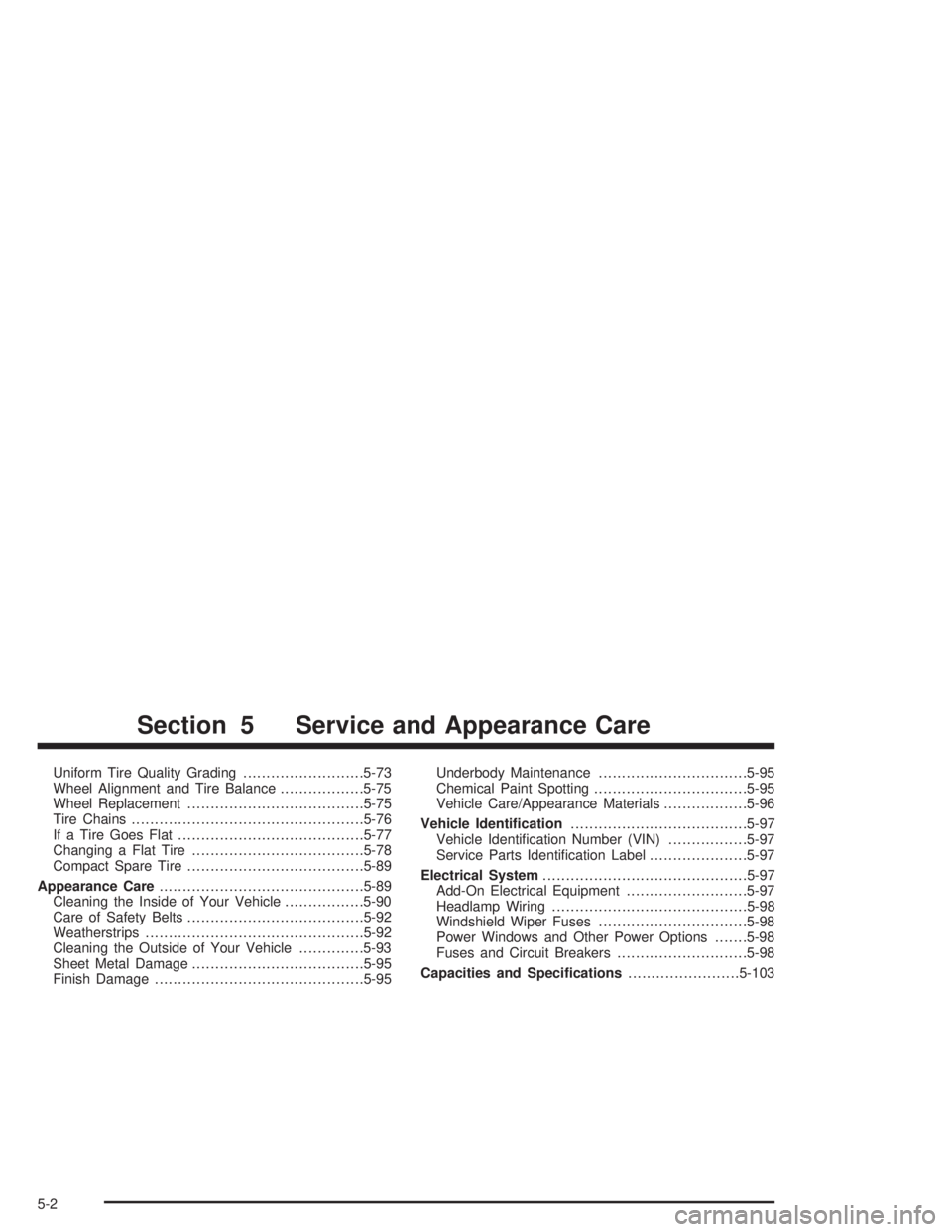
Uniform Tire Quality Grading..........................5-73
Wheel Alignment and Tire Balance..................5-75
Wheel Replacement......................................5-75
Tire Chains..................................................5-76
If a Tire Goes Flat........................................5-77
Changing a Flat Tire.....................................5-78
Compact Spare Tire......................................5-89
Appearance Care............................................5-89
Cleaning the Inside of Your Vehicle.................5-90
Care of Safety Belts......................................5-92
Weatherstrips...............................................5-92
Cleaning the Outside of Your Vehicle..............5-93
Sheet Metal Damage.....................................5-95
Finish Damage.............................................5-95Underbody Maintenance................................5-95
Chemical Paint Spotting.................................5-95
Vehicle Care/Appearance Materials..................5-96
Vehicle Identi�cation......................................5-97
Vehicle Identi�cation Number (VIN).................5-97
Service Parts Identi�cation Label.....................5-97
Electrical System............................................5-97
Add-On Electrical Equipment..........................5-97
Headlamp Wiring..........................................5-98
Windshield Wiper Fuses................................5-98
Power Windows and Other Power Options.......5-98
Fuses and Circuit Breakers............................5-98
Capacities and Speci�cations........................5-103
Section 5 Service and Appearance Care
5-2
Page 261 of 354

Headlamp Aiming
The vehicle has a headlamp system equipped with
horizontal and vertical aim indicators. The aim has been
pre-set at the factory and should need no further
adjustment. This is true even though the vertical and
horizontal aim indicators may not fall exactly on
the “0” (zero) marks on their scales.
If the vehicle is damaged in an accident, the headlamp
aim may be affected. Aim adjustment may be
necessary if it is difficult to see lane markers, for
horizontal aim, or if oncoming drivers �ash their high
beams at you, for vertical aim. If you believe the
headlamps need to be re-aimed, we recommend that
you take it to your dealer for service; however, it is
possible for you to re-aim the headlamps as described
in the following procedure.
Notice:To make sure your headlamps are aimed
properly, read all the instructions before beginning.
Failure to follow these instructions could cause
damage to headlamp parts.To check the aim, the vehicle should be properly
prepared as follows:The headlamps must be off for one hour prior to
aiming and must remain off during this procedure.
The vehicle must have all four tires on a perfectly
level surface.
If necessary, pads may be used on an uneven
surface to help level the vehicle.
The vehicle should not have any snow, ice or mud
attached to it.
The vehicle should be fully assembled and all other
work stopped while headlamp aiming is being done.
There should not be any cargo or loading of the
vehicle. It should however, have a full fuel tank and
one person or 160 lbs (75 kg) on the driver’s seat.
Close all doors.
Tires should be properly in�ated.
Rock the vehicle to stabilize the suspension.
5-53
Page 262 of 354
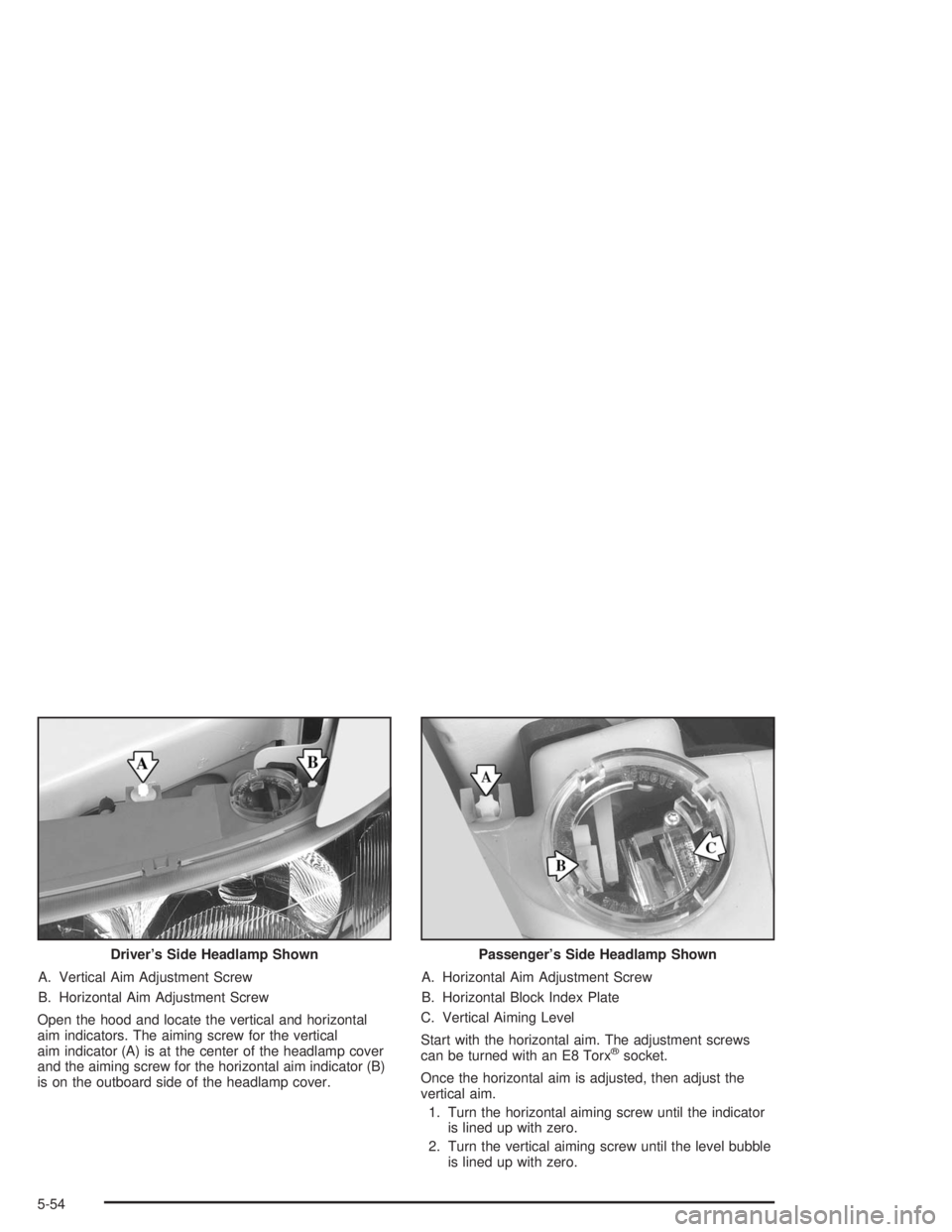
A. Vertical Aim Adjustment Screw
B. Horizontal Aim Adjustment Screw
Open the hood and locate the vertical and horizontal
aim indicators. The aiming screw for the vertical
aim indicator (A) is at the center of the headlamp cover
and the aiming screw for the horizontal aim indicator (B)
is on the outboard side of the headlamp cover.A. Horizontal Aim Adjustment Screw
B. Horizontal Block Index Plate
C. Vertical Aiming Level
Start with the horizontal aim. The adjustment screws
can be turned with an E8 Torx
®socket.
Once the horizontal aim is adjusted, then adjust the
vertical aim.
1. Turn the horizontal aiming screw until the indicator
is lined up with zero.
2. Turn the vertical aiming screw until the level bubble
is lined up with zero. Driver’s Side Headlamp Shown
Passenger’s Side Headlamp Shown
5-54
Page 263 of 354
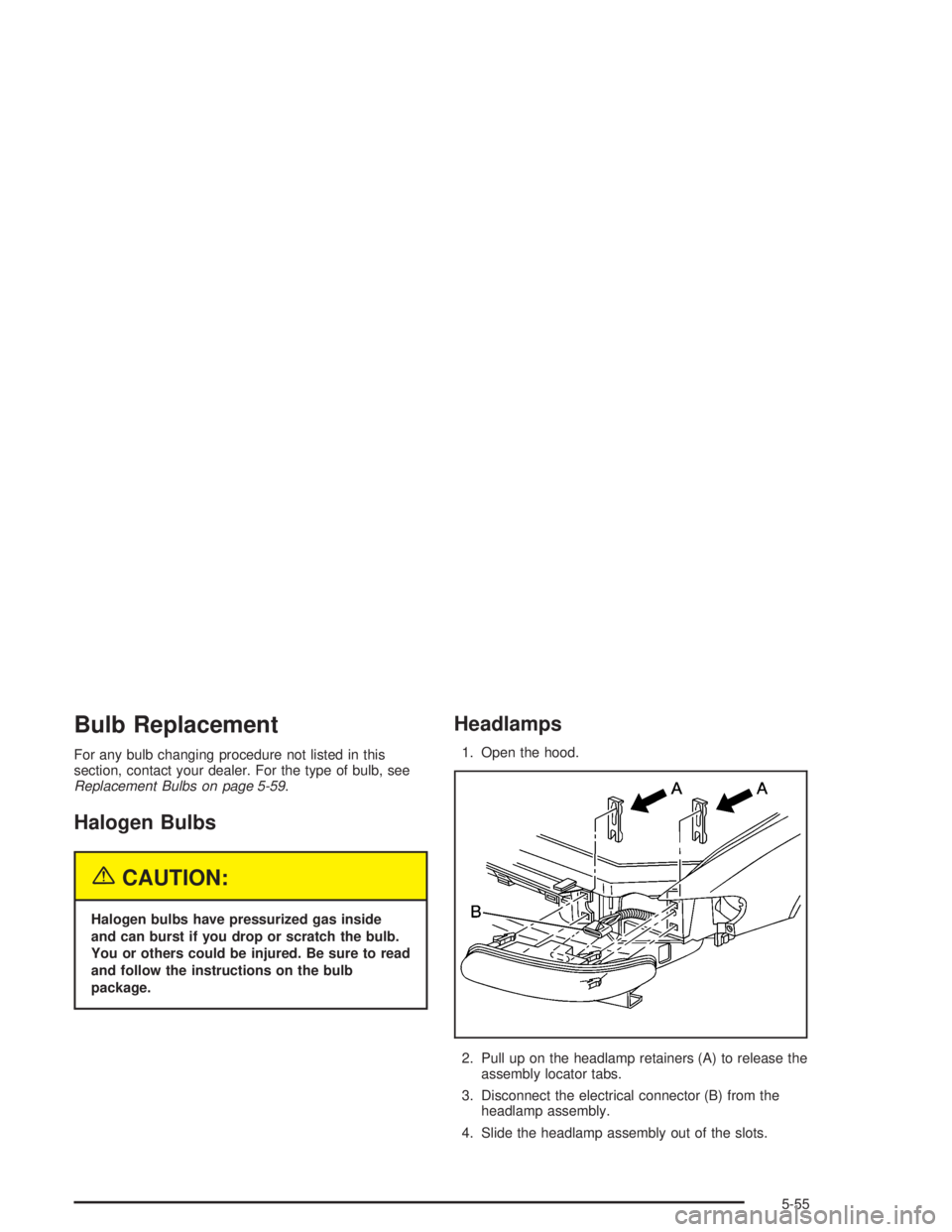
Bulb Replacement
For any bulb changing procedure not listed in this
section, contact your dealer. For the type of bulb, see
Replacement Bulbs on page 5-59.
Halogen Bulbs
{CAUTION:
Halogen bulbs have pressurized gas inside
and can burst if you drop or scratch the bulb.
You or others could be injured. Be sure to read
and follow the instructions on the bulb
package.
Headlamps
1. Open the hood.
2. Pull up on the headlamp retainers (A) to release the
assembly locator tabs.
3. Disconnect the electrical connector (B) from the
headlamp assembly.
4. Slide the headlamp assembly out of the slots.
5-55